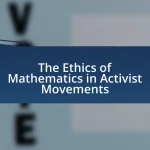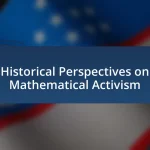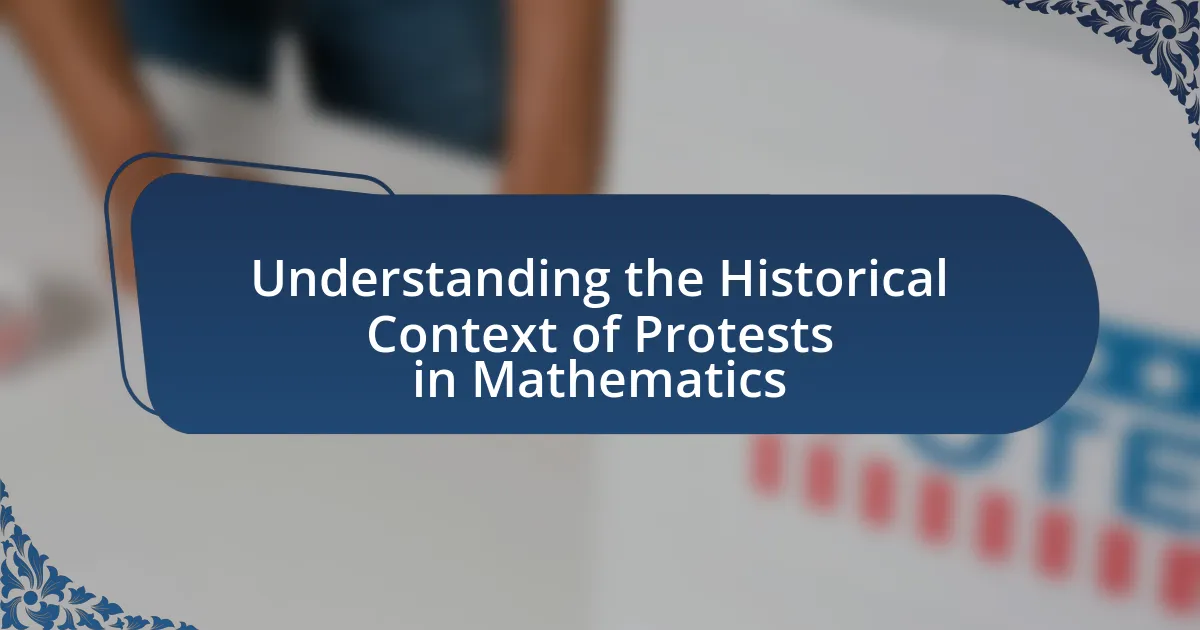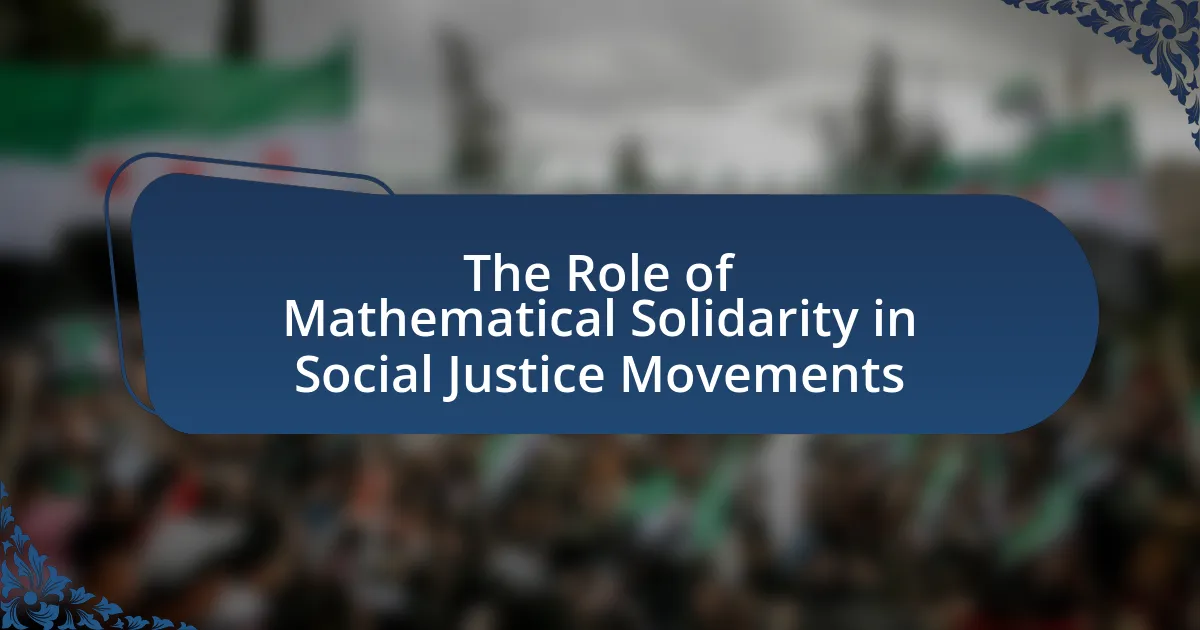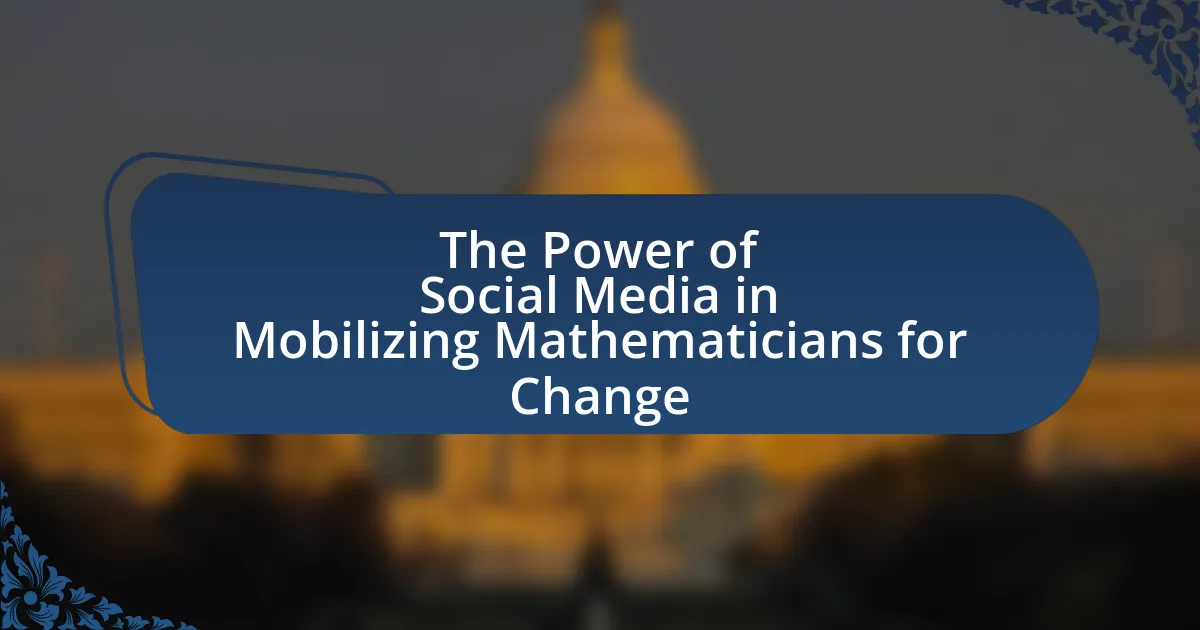The article explores the lessons mathematicians can learn from protests in the arts and sciences, emphasizing the significance of advocacy and social responsibility. It discusses how protests can challenge existing paradigms, influence mathematical thought, and promote interdisciplinary collaboration. Historical examples illustrate the impact of activism on mathematics, while practical strategies for community engagement and effective advocacy are outlined. The article highlights the importance of integrating insights from various disciplines to enhance mathematical practices and address societal issues.
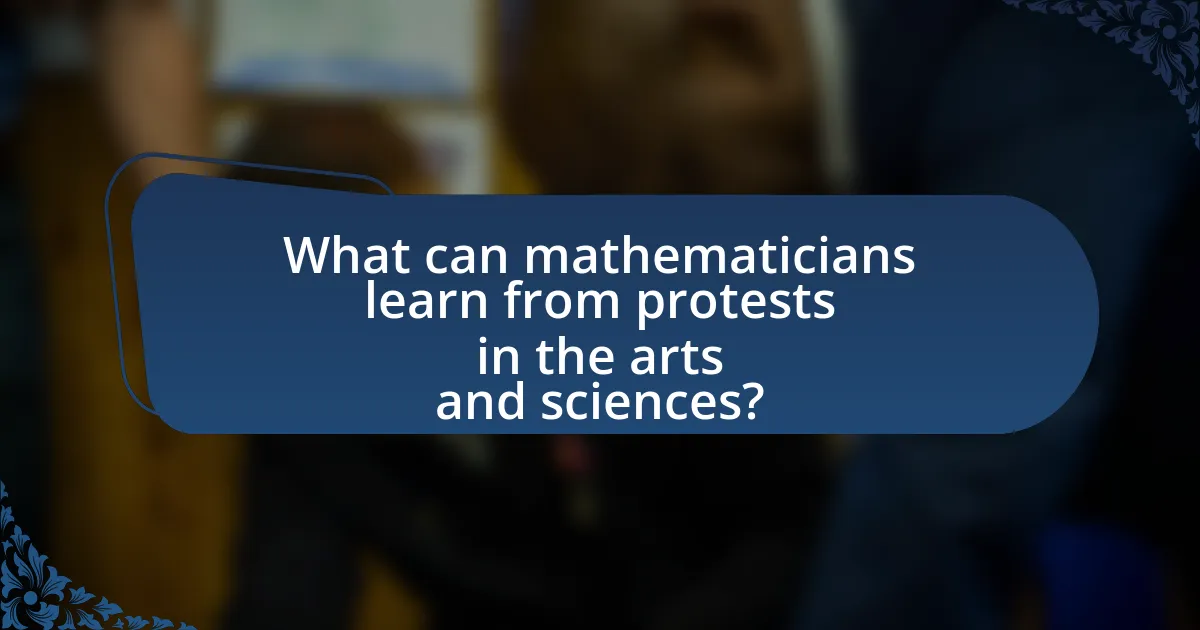
What can mathematicians learn from protests in the arts and sciences?
Mathematicians can learn the importance of advocacy and social responsibility from protests in the arts and sciences. Protests often highlight the need for ethical considerations in research and the impact of societal issues on scientific progress. For instance, the 2017 March for Science emphasized the necessity of defending scientific integrity and funding, which parallels the need for mathematicians to advocate for the relevance of their work in addressing real-world problems. Additionally, the arts have demonstrated how collective action can drive change, illustrating to mathematicians the power of collaboration and community engagement in promoting their discipline’s value and relevance.
How do protests in other disciplines influence mathematical thought?
Protests in other disciplines influence mathematical thought by challenging existing paradigms and encouraging critical examination of underlying assumptions. For instance, the civil rights movement prompted mathematicians to reconsider the ethical implications of their work, leading to a focus on social justice within mathematical applications. Historical examples include the activism surrounding the Vietnam War, which inspired mathematicians to engage with issues of war and peace, ultimately affecting the development of mathematical models in social sciences. These movements demonstrate that interdisciplinary dialogue can reshape mathematical inquiry, fostering a more inclusive and socially aware approach to the discipline.
What historical examples illustrate the impact of protests on mathematics?
Protests have historically influenced mathematics, notably during the Civil Rights Movement in the United States, where activists highlighted the need for equitable education, including mathematics. This activism led to reforms in educational policies, promoting the inclusion of diverse mathematical perspectives and curricula that addressed social justice issues. For instance, the push for desegregation in schools resulted in increased access to quality mathematics education for marginalized communities, thereby reshaping the mathematical landscape. Additionally, the protests against the Vietnam War in the 1960s prompted mathematicians to reconsider the ethical implications of their work, leading to a greater emphasis on the social responsibilities of mathematicians in their research and applications. These examples demonstrate that protests can catalyze significant changes in the field of mathematics, influencing both educational practices and the ethical considerations of mathematical research.
How can the methodologies of protests inform mathematical practices?
The methodologies of protests can inform mathematical practices by emphasizing the importance of collective action, critical thinking, and data-driven decision-making. Protests often rely on organizing communities around shared goals, which parallels collaborative mathematical research that benefits from diverse perspectives and teamwork. Furthermore, the strategic use of data in protests, such as statistics on social issues, can enhance mathematical modeling and analysis by providing real-world context and relevance. For instance, the use of quantitative data in movements like Black Lives Matter has highlighted systemic inequalities, prompting mathematicians to apply statistical methods to address these issues. This integration of social awareness into mathematical practices fosters a more holistic approach to problem-solving and encourages mathematicians to consider the societal implications of their work.
Why is interdisciplinary learning important for mathematicians?
Interdisciplinary learning is important for mathematicians because it enhances their problem-solving skills and broadens their perspective on complex issues. By engaging with fields such as physics, biology, and social sciences, mathematicians can apply mathematical concepts to real-world problems, leading to innovative solutions. For instance, the application of mathematical modeling in epidemiology during the COVID-19 pandemic demonstrated how mathematical techniques could inform public health strategies. This cross-disciplinary approach not only fosters creativity but also encourages collaboration, which is essential for tackling multifaceted challenges in today’s interconnected world.
What benefits arise from integrating insights from the arts and sciences into mathematics?
Integrating insights from the arts and sciences into mathematics enhances creativity, fosters interdisciplinary collaboration, and promotes innovative problem-solving. This integration allows mathematicians to approach complex problems with diverse perspectives, leading to novel solutions. For instance, the use of visual arts in mathematical education has been shown to improve spatial reasoning skills, which are crucial for understanding geometric concepts. Additionally, scientific principles can inform mathematical modeling, as seen in fields like bioinformatics, where mathematical techniques are applied to biological data analysis. Such interdisciplinary approaches have been documented in studies, including “Mathematics and the Arts: A New Perspective” by authors from the University of California, which highlights the positive impact of arts integration on mathematical understanding and engagement.
How can mathematicians apply lessons from protests to enhance their work?
Mathematicians can apply lessons from protests by embracing collective action and interdisciplinary collaboration to address societal issues through mathematical modeling and data analysis. Protests often highlight systemic inequalities and urgent social problems, prompting mathematicians to utilize their skills in statistics and predictive modeling to analyze data related to these issues, such as public health disparities or climate change impacts. For instance, during the COVID-19 pandemic, mathematicians contributed to modeling the spread of the virus, which was informed by public protests advocating for health equity. This demonstrates how engaging with social movements can lead to relevant mathematical applications that not only enhance their work but also contribute to societal progress.
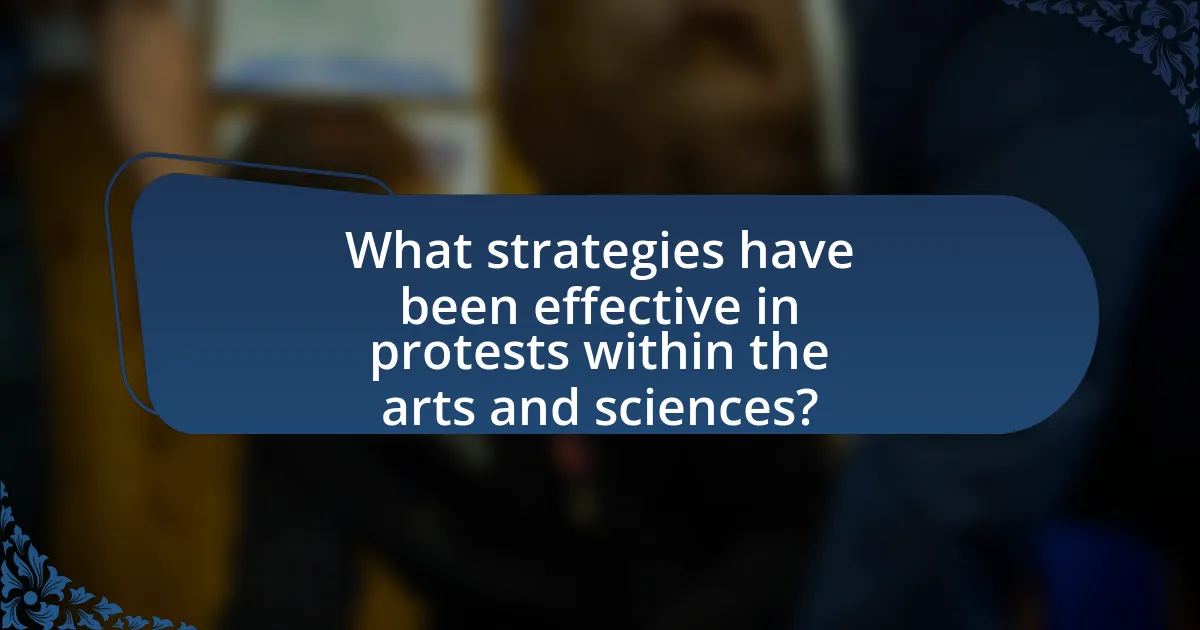
What strategies have been effective in protests within the arts and sciences?
Effective strategies in protests within the arts and sciences include coalition-building, public engagement, and leveraging social media. Coalition-building allows diverse groups to unite around common goals, enhancing visibility and impact; for example, the collaboration between artists and scientists during the climate change protests has amplified their messages. Public engagement through performances, exhibitions, and lectures fosters community involvement and raises awareness, as seen in the “Art for Science” initiatives that connect artistic expression with scientific discourse. Additionally, leveraging social media platforms has proven crucial for mobilizing support and disseminating information rapidly, exemplified by the #MeToo movement in the arts, which utilized social media to amplify voices and drive change. These strategies demonstrate a multifaceted approach that effectively addresses issues within the arts and sciences.
How can these strategies be adapted for mathematical advocacy?
Strategies from protests in the arts and sciences can be adapted for mathematical advocacy by emphasizing community engagement, clear communication of mathematical concepts, and the use of visual storytelling. Community engagement can be fostered through collaborative projects that involve diverse stakeholders, similar to how artists and scientists mobilize public support. Clear communication is essential; mathematicians can simplify complex ideas and relate them to real-world issues, akin to how activists frame their messages for broader audiences. Visual storytelling, such as infographics and interactive demonstrations, can make mathematical concepts more accessible, paralleling the effective use of visuals in art and science protests. These adaptations can enhance the visibility and relevance of mathematics in societal discussions, as evidenced by successful advocacy campaigns in other fields that have utilized these strategies to mobilize support and drive change.
What role does community engagement play in successful protests?
Community engagement is crucial for successful protests as it fosters solidarity, amplifies voices, and mobilizes resources. Engaged communities are more likely to participate actively, leading to larger turnout numbers, which can attract media attention and sway public opinion. Historical examples, such as the Civil Rights Movement, demonstrate that grassroots involvement was essential in organizing events, spreading awareness, and sustaining momentum. Research indicates that protests with high community involvement are more effective in achieving their goals, as seen in studies analyzing the impact of local networks on protest outcomes.
How can mathematicians leverage social media for advocacy?
Mathematicians can leverage social media for advocacy by creating engaging content that highlights the importance of mathematics in societal issues. By sharing infographics, videos, and articles that connect mathematical concepts to real-world problems, mathematicians can raise awareness and foster public interest. For instance, the use of Twitter hashtags like #MathForChange has successfully mobilized discussions around the role of mathematics in addressing climate change and public health crises. This approach not only educates the public but also encourages collaboration among mathematicians and other disciplines, amplifying their collective voice in advocacy efforts.
What challenges do mathematicians face when learning from other disciplines?
Mathematicians face challenges such as the abstraction of concepts and differing terminologies when learning from other disciplines. The abstract nature of mathematics can make it difficult for mathematicians to grasp practical applications or methodologies used in fields like the arts and sciences, where context and interpretation play significant roles. Additionally, the specialized language and jargon prevalent in other disciplines can create barriers to effective communication and understanding. For instance, a mathematician may struggle to translate mathematical models into the qualitative frameworks used in social sciences, leading to potential misinterpretations of data or concepts.
How can resistance to change be overcome in mathematical communities?
Resistance to change in mathematical communities can be overcome by fostering open dialogue and collaboration among members. Engaging mathematicians in discussions about the benefits of change, such as improved teaching methods or innovative research approaches, can create a shared vision that encourages acceptance. Historical examples, such as the adoption of new pedagogical techniques in STEM education, demonstrate that when communities actively involve their members in the change process, resistance diminishes. Additionally, providing professional development opportunities that highlight successful case studies from other disciplines can further motivate mathematicians to embrace change.
What misconceptions about interdisciplinary approaches exist among mathematicians?
Mathematicians often hold misconceptions that interdisciplinary approaches dilute the rigor of mathematics or that they are irrelevant to pure mathematical inquiry. These beliefs stem from a traditional view that prioritizes abstract reasoning over practical applications. However, research indicates that interdisciplinary collaboration can enhance mathematical understanding and innovation, as seen in fields like mathematical biology and data science, where mathematical techniques solve real-world problems. This evidence demonstrates that engaging with other disciplines not only preserves mathematical rigor but also expands its applicability and relevance.
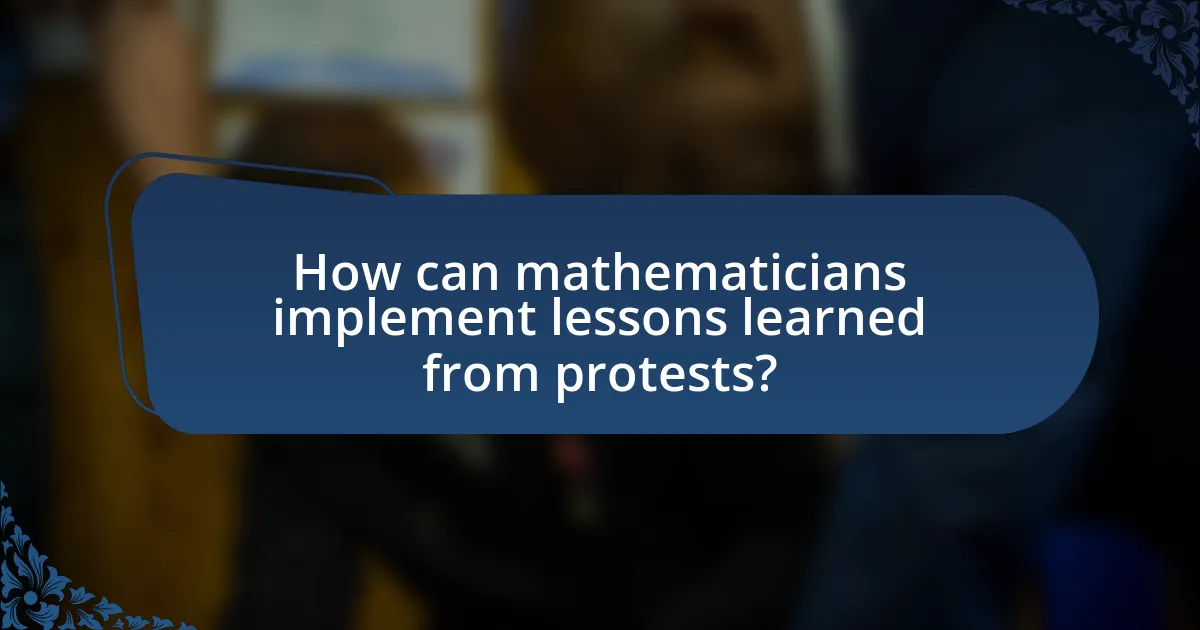
How can mathematicians implement lessons learned from protests?
Mathematicians can implement lessons learned from protests by applying data analysis techniques to understand social dynamics and public sentiment. For instance, they can utilize statistical models to analyze protest data, such as participant demographics and geographic distribution, which can reveal patterns in social movements. Historical examples, like the analysis of the Civil Rights Movement, demonstrate how quantitative methods helped identify key factors influencing public support and policy changes. By integrating these analytical approaches, mathematicians can contribute to more effective advocacy and policy formulation in response to societal issues.
What practical steps can mathematicians take to engage with social issues?
Mathematicians can engage with social issues by applying their analytical skills to data-driven advocacy, collaborating with interdisciplinary teams, and participating in public discourse. By analyzing social data, mathematicians can provide insights into issues such as inequality, climate change, and public health, thereby influencing policy decisions. Collaborating with experts from fields like sociology, economics, and environmental science allows mathematicians to contribute their quantitative expertise to broader discussions. Additionally, participating in public forums, writing articles, or giving talks can raise awareness and promote understanding of mathematical perspectives on social issues. These steps demonstrate the relevance of mathematics in addressing real-world challenges.
How can collaborative projects between mathematicians and artists be initiated?
Collaborative projects between mathematicians and artists can be initiated through interdisciplinary workshops that encourage dialogue and idea exchange. These workshops can serve as platforms for both groups to present their work, identify common interests, and brainstorm potential collaborative projects. For instance, events like the “Mathematics and Art” conferences have successfully brought together professionals from both fields, leading to innovative projects that blend mathematical concepts with artistic expression. Such initiatives demonstrate the effectiveness of structured environments in fostering collaboration and creativity.
What resources are available for mathematicians interested in activism?
Mathematicians interested in activism can access various resources, including organizations like the American Mathematical Society (AMS) and the Mathematical Association of America (MAA), which provide platforms for advocacy and community engagement. Additionally, initiatives such as the Mathematicians for Social Justice network offer collaborative opportunities and resources focused on social issues. Research papers and articles discussing the intersection of mathematics and activism, such as “Mathematics and Social Justice” by the MAA, provide insights and case studies that can guide mathematicians in their activism efforts. These resources collectively support mathematicians in understanding and participating in activism effectively.
What are the best practices for mathematicians to advocate effectively?
Mathematicians can advocate effectively by engaging in clear communication, building coalitions, and utilizing data-driven arguments. Clear communication involves translating complex mathematical concepts into accessible language for diverse audiences, which enhances understanding and support. Building coalitions with other disciplines, such as the arts and sciences, can amplify voices and create a united front for advocacy efforts. Utilizing data-driven arguments strengthens advocacy by providing concrete evidence that supports claims, making them more persuasive. For instance, the success of advocacy campaigns in the sciences often relies on presenting statistical data that highlights the importance of funding and resources, demonstrating that similar strategies can be effective for mathematicians as well.
How can mathematicians measure the impact of their advocacy efforts?
Mathematicians can measure the impact of their advocacy efforts through quantitative metrics such as changes in policy, increased funding for mathematics education, and engagement levels in public discourse. For instance, tracking the number of legislative bills influenced by mathematical research or the amount of funding allocated to math programs after advocacy campaigns provides concrete data on effectiveness. Additionally, surveys assessing public awareness and attitudes towards mathematics before and after advocacy initiatives can quantify shifts in perception, demonstrating the reach and influence of their efforts.
What role does education play in fostering a culture of activism among mathematicians?
Education plays a crucial role in fostering a culture of activism among mathematicians by equipping them with critical thinking skills and a sense of social responsibility. Through curricula that emphasize the ethical implications of mathematical work and the importance of community engagement, educational institutions can inspire mathematicians to apply their skills in addressing societal issues. For instance, programs that integrate social justice themes into mathematics education encourage students to recognize the impact of their work on real-world problems, thus promoting activism. Research indicates that when mathematicians are educated about the historical context of their discipline and its potential for societal change, they are more likely to engage in activism, as seen in initiatives like the “Mathematics for Social Justice” movement.

